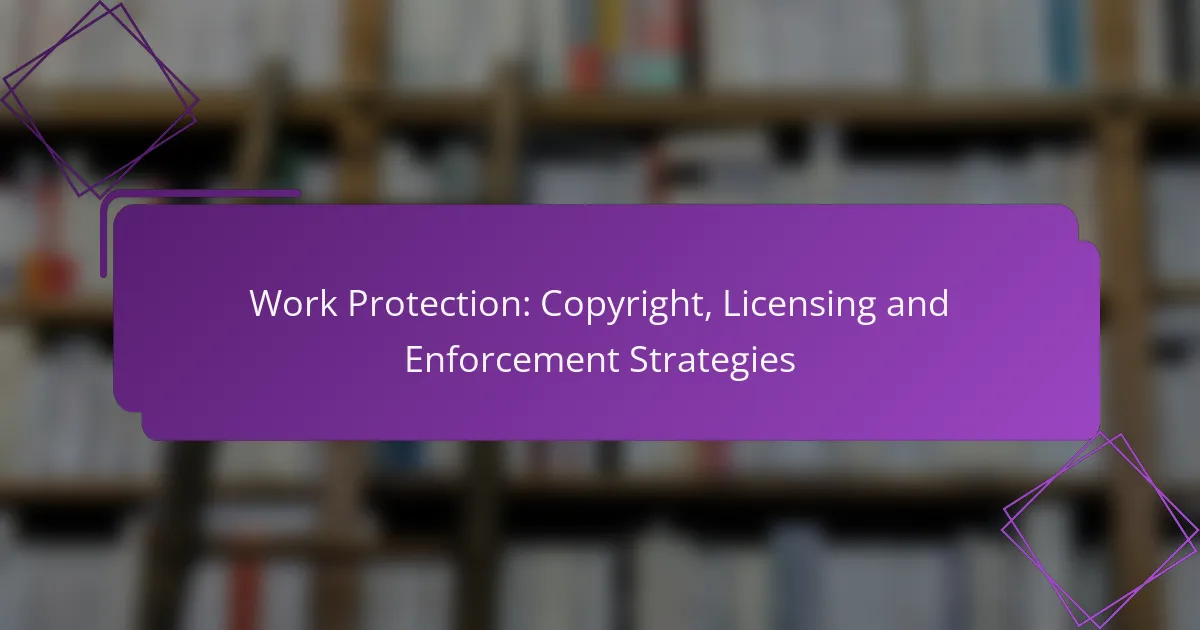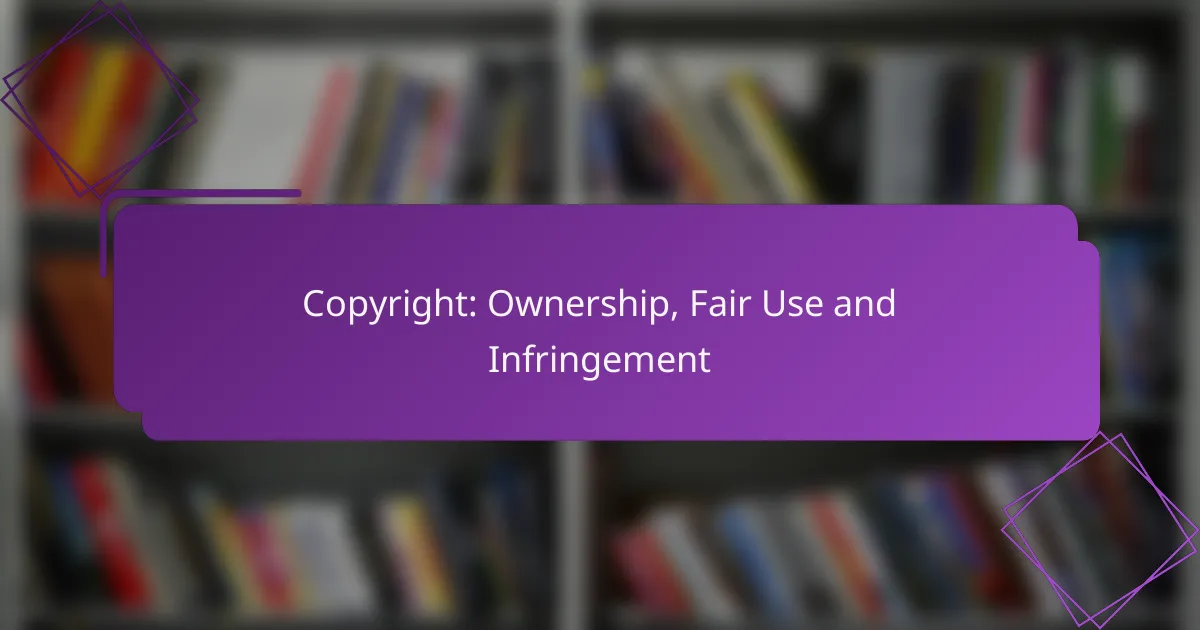Protecting your work through copyright is essential in today’s digital landscape, where unauthorized use can easily occur. Implementing effective strategies such as registering your work, utilizing licenses, and enforcing your rights can help you maintain control over your intellectual property. By understanding these methods, creators can safeguard their creations while also exploring monetization opportunities and addressing potential infringements effectively.
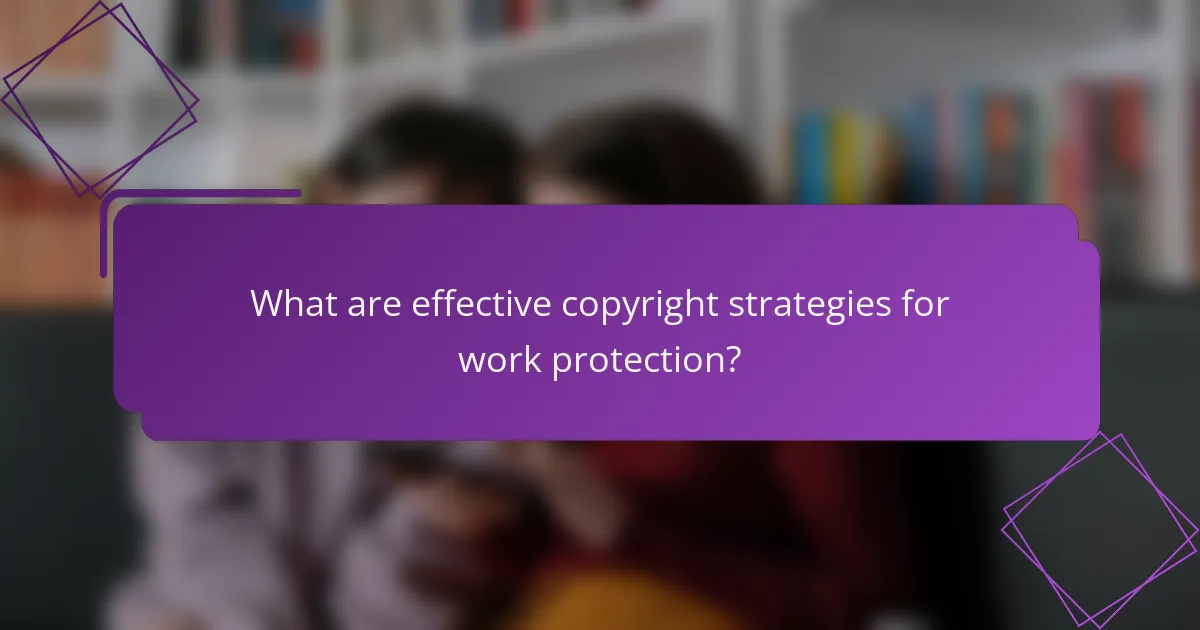
What are effective copyright strategies for work protection?
Effective copyright strategies for work protection include registering your work, utilizing licenses, and implementing digital rights management. These approaches help safeguard your intellectual property and ensure you maintain control over its use and distribution.
Registering copyrights with the U.S. Copyright Office
Registering your copyright with the U.S. Copyright Office provides legal benefits, including the ability to sue for statutory damages and attorney’s fees in case of infringement. The process involves submitting an application, a copy of your work, and a fee, which typically ranges from $45 to $125, depending on the type of registration.
Once registered, your copyright is protected for the life of the author plus 70 years, or for corporate works, 95 years from publication or 120 years from creation, whichever is shorter. This long-term protection is crucial for creators looking to secure their rights over time.
Utilizing Creative Commons licenses
Creative Commons licenses allow creators to specify how others can use their work while retaining some rights. These licenses range from very permissive, allowing for commercial use and modifications, to more restrictive options that limit use to non-commercial purposes and require attribution.
Choosing the right Creative Commons license can enhance your work’s visibility and encourage sharing while protecting your interests. For example, the Attribution-NonCommercial-ShareAlike license allows others to remix your work as long as they credit you and do not use it commercially.
Implementing digital rights management (DRM)
Digital rights management (DRM) involves using technology to control how digital content is accessed and used. DRM can prevent unauthorized copying, sharing, or modification of your work, making it a vital tool for protecting digital media such as e-books, music, and software.
While DRM can be effective, it may also limit user experience and accessibility. Consider balancing protection with usability; for instance, providing a user-friendly way to access your content while still enforcing restrictions can help maintain customer satisfaction.

How can licensing enhance work protection?
Licensing enhances work protection by granting specific rights to use a creator’s intellectual property while retaining ownership. This legal framework allows creators to monetize their work and control how it is used, reducing the risk of unauthorized exploitation.
Types of licensing agreements
Licensing agreements can vary widely, but they generally fall into a few key categories. Exclusive licenses grant one party the sole rights to use the work, while non-exclusive licenses allow multiple parties to use it simultaneously. Other types include sole licenses, which give one party the rights but still allow the creator to use the work.
Additionally, licenses can be limited by territory, duration, or specific applications. For example, a creator might license their work for use in a particular country for a set number of years, ensuring control over its distribution.
Negotiating fair licensing terms
Negotiating fair licensing terms is crucial for both creators and licensees. Key factors to consider include the scope of use, duration, and compensation. Creators should aim for terms that reflect the value of their work while ensuring that licensees can effectively utilize it.
It’s advisable to conduct market research to understand standard rates and practices in your industry. This knowledge can empower creators during negotiations and help avoid common pitfalls, such as undervaluing their work or agreeing to overly restrictive terms.
Understanding exclusive vs. non-exclusive licenses
Exclusive licenses provide a single licensee with the right to use the work, often resulting in higher fees due to the limited availability. This type of license is beneficial for licensees seeking a competitive edge, as it prevents others from using the same material.
In contrast, non-exclusive licenses allow multiple parties to use the same work, which can lead to broader exposure for the creator and potentially more revenue streams. Understanding the trade-offs between these two types of licenses is essential for making informed decisions that align with business goals.
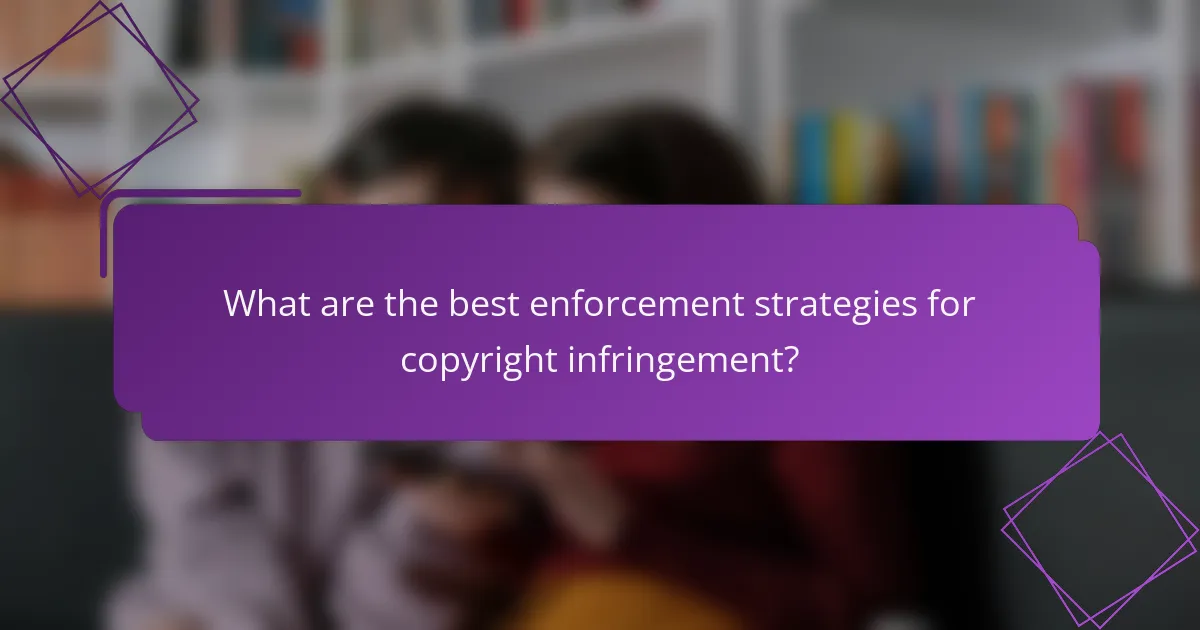
What are the best enforcement strategies for copyright infringement?
The best enforcement strategies for copyright infringement include sending cease and desist letters, pursuing legal action in federal court, and utilizing online takedown notices. Each method has its own advantages and considerations, depending on the severity of the infringement and the desired outcome.
Sending cease and desist letters
Cease and desist letters are formal requests to infringers to stop using copyrighted material. They serve as a warning and can often resolve issues without further legal action. It’s essential to clearly outline the copyright ownership and the specific infringements in the letter.
When drafting a cease and desist letter, ensure it is professional and concise. Include a deadline for compliance, typically ranging from 10 to 30 days, to encourage prompt action. This approach can save time and legal costs if the infringer complies.
Pursuing legal action in federal court
Pursuing legal action in federal court is a more aggressive enforcement strategy for serious copyright infringement cases. This option is suitable when the infringer refuses to comply with cease and desist letters or when significant damages are involved. Legal action can result in monetary damages and injunctions against further infringement.
Before proceeding, consider the costs and time associated with litigation, which can be substantial. It is advisable to consult with an attorney who specializes in copyright law to assess the strength of your case and the potential outcomes.
Utilizing online takedown notices
Online takedown notices are effective tools for removing infringing content from websites and platforms. Under the Digital Millennium Copyright Act (DMCA), copyright holders can submit a takedown notice to service providers, prompting them to remove infringing material quickly.
To utilize this strategy, gather evidence of the infringement and prepare a detailed notice that includes your contact information and a description of the copyrighted work. Many platforms have specific forms for submitting takedown requests, so familiarize yourself with their requirements to ensure compliance and expedite the process.

What criteria should be considered when selecting a licensing model?
Selecting a licensing model requires careful consideration of factors such as market reach, audience demographics, and potential revenue streams. Each model has its own implications for how intellectual property is utilized and monetized.
Assessing market reach and audience
Understanding your market reach and audience is crucial when choosing a licensing model. Consider the demographics, preferences, and behaviors of your target audience to ensure that the licensing model aligns with their needs.
For example, if your audience is primarily digital-savvy, a model that emphasizes online distribution may be more effective. Conversely, if your audience values physical products, a traditional licensing approach might be better suited.
Evaluating potential revenue streams
Evaluating potential revenue streams involves analyzing how different licensing models can generate income. Consider whether you want to pursue upfront fees, royalties, or a combination of both, as each model can significantly impact cash flow.
For instance, a royalty-based model might yield higher long-term revenue but requires ongoing sales performance, while an upfront fee provides immediate income. Assessing your financial goals will help determine the most suitable approach.
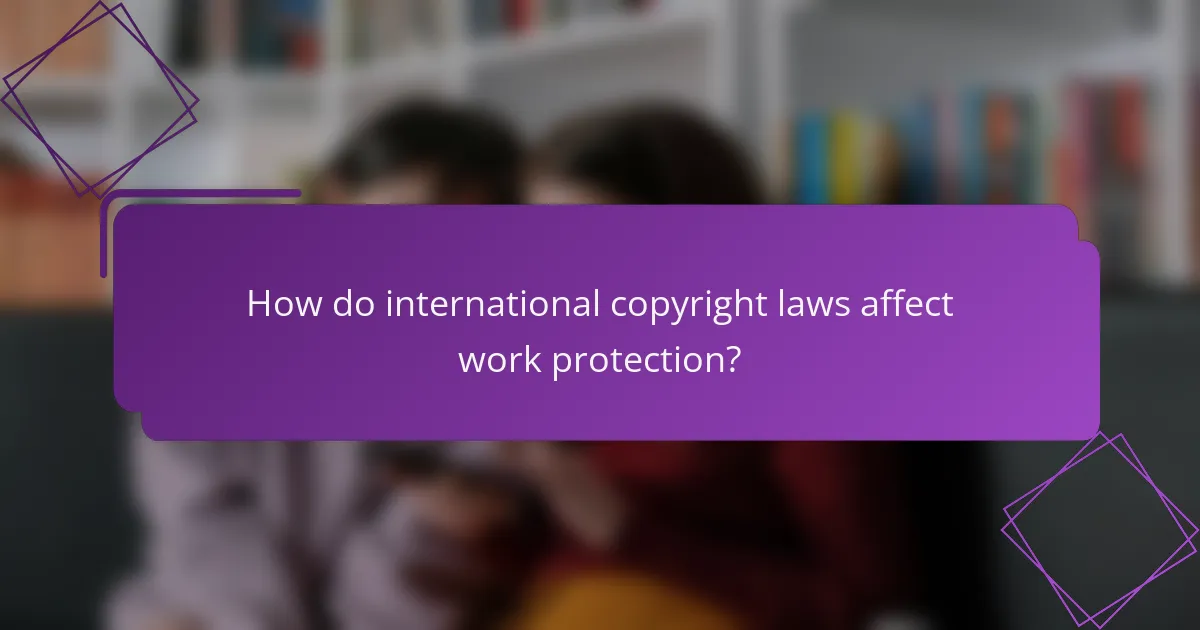
How do international copyright laws affect work protection?
International copyright laws play a crucial role in protecting creative works across borders. They establish a framework that allows creators to safeguard their intellectual property while ensuring that their rights are recognized in multiple jurisdictions.
Understanding the Berne Convention
The Berne Convention is a key international treaty that governs copyright protection. It mandates that member countries recognize the copyright of works created by authors from other member states, ensuring a minimum level of protection without the need for formal registration.
Under the Berne Convention, creators enjoy rights such as reproduction, distribution, and public performance of their works. This treaty emphasizes the principle of “national treatment,” meaning that foreign authors should receive the same protection as domestic authors in a given country.
Recognizing differences in enforcement across countries
Enforcement of copyright laws can vary significantly from one country to another, impacting how effectively creators can protect their works. Some countries have robust legal frameworks and active enforcement mechanisms, while others may lack resources or political will to uphold copyright protections.
For instance, in the United States, copyright infringement cases can lead to substantial damages, while in some developing nations, enforcement may be less stringent, making it harder for creators to pursue legal action. Understanding these differences is essential for creators looking to protect their works internationally.
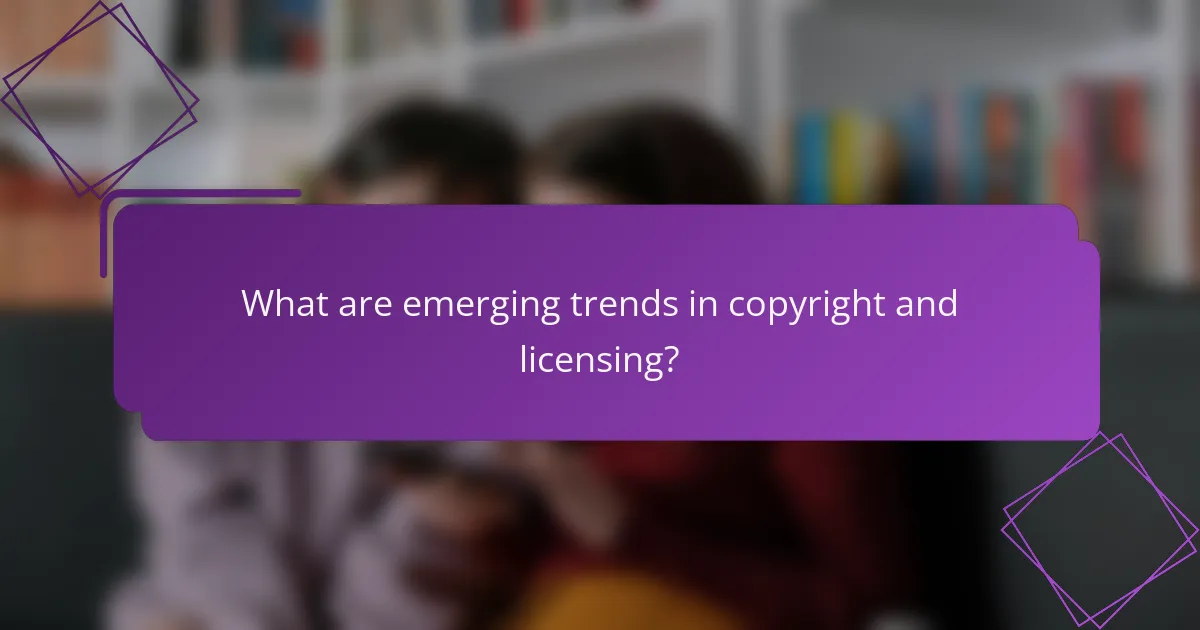
What are emerging trends in copyright and licensing?
Emerging trends in copyright and licensing are significantly influenced by technological advancements and changing content creation practices. Key developments include the integration of blockchain for copyright management and the rise of AI-generated content, both of which present new challenges and opportunities for creators and businesses.
Impact of blockchain on copyright management
Blockchain technology is revolutionizing copyright management by providing a decentralized and transparent system for tracking ownership and usage rights. This technology allows creators to register their works on a blockchain, ensuring that their intellectual property is securely documented and easily accessible.
By using smart contracts, creators can automate licensing agreements, which can streamline the process of monetizing their work. For instance, artists can set specific terms for usage and receive payments automatically when their work is used, reducing the need for intermediaries.
Growth of AI-generated content and copyright implications
The growth of AI-generated content raises significant copyright implications, particularly concerning ownership and originality. As AI systems create music, art, and written content, questions arise about who holds the copyright—the developer of the AI, the user, or the AI itself.
Creators should be aware that while AI can assist in content creation, they must ensure that their work remains original to avoid potential copyright infringement. Establishing clear guidelines on the use of AI tools and understanding the legal landscape surrounding AI-generated works is essential for protecting intellectual property.
